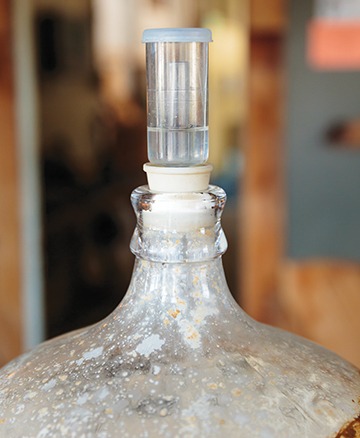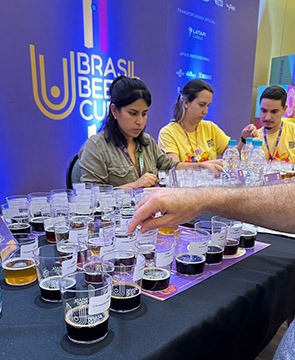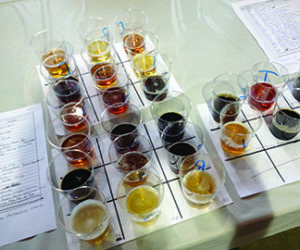Rethinking Beer Faults
When I judge in competitions, people often ask me about memorable beers. I think they expect me to mention the exceptional homebrews that could pass as award-winning commercial examples. However, I’m more likely to describe the truly awful ones that leave a lingering memory. Judging in more than 400 competitions over 25 years has given me plenty of examples of both. Hopefully, judges help brewers graduate to the more favorable type of memory.

Great beers stand out immediately. Bad beers are fairly obvious. But the wide range of intermediate beers require the most thought since their problems are rarely simplistic. They may involve problems with the style interpretation, or they could be actual brewing faults. Faults could be single or occur in combination. The problems could happen throughout the brewing process, starting with the original concept and continuing through the handling, storage, and service processes where the beer is consumed.
I used to think about faults as individual elements to detect, but they are really part of the larger framework of the entire sensory experience of the beer. Beers are rarely perfect except for one noticeable fault. More often, there are multiple faults of varying degrees that help the judge determine what underlying problems caused them. This diagnosis then provides the most useful assessment for the brewer.
Sources of Faults
The more I judge, the more I start thinking about where problems are introduced. I like to break up the brewing process into four phases where mistakes may happen to cause problems in the finished beer:
1. Recipe formulation and ingredient selection
2. Brewing and hot-side processes
3. Fermentation and cold-side processes
4. Packaging, storage, and handling processes
If I can isolate problems to these stages, it lets me focus on a smaller subset of possible faults rather than thinking about the entire universe of brewing issues.
Recipe and Ingredient Problems

These often produce beers that don’t match style profiles well. Contaminated or stale ingredients can lead to noticeable flavor defects. The choice of certain ingredients could clash with each other, producing unpalatable results. Sometimes this effect is cumulative, like when gypsum in water combines with sulfury dank hops or sulfur thrown off by lager yeast to create an objectionable amount of sulfur in the finished beer. Newer hop varieties can have complex profiles, and some competing hop combinations can be unpleasant. Sometimes problems are traced to changing ingredients. Different maltsters produce crystal malts with different flavor profiles, even if they have similar color. As municipalities change water sources during the year (sometimes during the course of a day), they may be making different treatments (like adding additional chlorine that could persist enough to cause a medicinal chlorophenolic flavor under certain conditions).
Hot-Side Problems
The hot side of brewing involves mashing and boiling. Style-related problems could be introduced here, including problems with body, fermentability, and sweetness levels. Process-related problems like incorrect mash temperatures, not having a proper pH during the mash or boil, or scorching the wort can produce significant impacts.
Cold-Side Problems
This is where yeast issues are typically introduced. Fermentation problems can produce significant off-flavors, but yeast performance can also lead to a beer not matching its expected parameters. I also include lagering and conditioning in this phase since many beers have temporary problems that can be reduced or eliminated during the maturation process. Beers that have some kind of post-processing, like barrel aging or mixed-fermentation maturation, can be impacted by these additional steps.
Packaging and Storage Problems
This phase is where oxidation and age-related issues are often produced or exacerbated. Sometimes the brewer has no control over the outcome, like when a beer is cellared past its prime. But sometimes the foundation for the problems is laid when the beer is packaged, like excessive dissolved oxygen in solution or bacterial contamination.
Common Faults Today
Recently, I’ve judged in both commercial and homebrew competitions in the U.S. and several other countries. Faults are sometimes regional, perhaps tied to ingredients, equipment, or knowledge common in the area. Other problems seem to be more universal, and are often related to the experience of a brewer. To follow are some of the more common ones I’ve seen recently.
Oxidation
This problem shows up almost everywhere, and is typically associated with packaging problems (too much oxygen in the package when it is sealed). Oxidation of ingredients can be seen with hoppy beers, or in some places where the malt is not well kept. But I almost never see the paper or cardboard oxidation that is tied to excessive oxidation during the hot side. Cold-side problems are much more common. I perceive these as dull, muted flavors, often with a sweetness and fruitiness. Some malt flavors are caramelly or honey-like, and the bitterness develops a harsh quality.
As a homebrewer, I try to control these issues by purging the packages with CO2 as well as making sure transfers aren’t splashing. If you are unsure of your packaging skills, storing your beers cold and consuming them quickly can minimize the oxidation that can occur by slowing the rate of oxidation.
Fermentation Problems

Incomplete, interrupted, or unhealthy fermentations produce beers containing excessive yeast byproducts, since the normal yeast metabolism processes don’t fully finish. Acetaldehyde is probably the most common problem, but it rarely shows up to me as green apple. It often just seems dirty. In some cases, I’ve perceived it as fresh-cut pumpkin or latex paint. But a general dirtiness is what happens most often. Brewers can control this by providing a healthy environment for yeast to ferment, including supplying micro-nutrients. Yeast gets the blame but often the root cause is the fermentation environment lacking in proper nutrients to support a healthy fermentation.
Diacetyl shows up less often, and is usually the result of prematurely separating the yeast from the beer (racking too soon, cold crashing, or otherwise not letting the yeast complete fermentation). While diacetyl has many other causes, I usually focus on the most likely problems first, unless there is some other evidence present (like indications of an infection or hop creep). Diacetyl rests can be used as a control, but I think letting the fermentation temperature free rise towards the end of the fermentation in general allows yeast to complete fermentation, reach final attenuation, and clean up their metabolic byproducts. Just don’t be too quick to remove the beer from the yeast. Professionals dump the trub and the yeast that has fallen out soon after the start of fermentation, but they let fermentation finish fully before transferring off the yeast.
Fusel alcohols are a solventy, burning type of alcohol produced from an unhealthy fermentation. This is not just a problem with ethanol not smoothing out with time, as fusels don’t really go away. Managing the fermentation in a controlled, healthy way can reduce their production. Trying to ferment too warm or too fast is often the problem. Fusels can cause annoying headaches, so this is one fault I hate to encounter.
Phenolic compounds are sometimes from yeast, typically the POF+ (phenolic off-flavor positive) yeast strains. They can come from wild yeast infections as well, and often have the Band-Aid or electrical fire flavors. Phenols are a large family of compounds and can come from other sources like the malt. But I look for the plastic-like flavors in conjunction with other markers for infection (like a chunky appearance and sourness) as one cause. Yeast strain selection is another, but that can be style-dependent. German wheat beers and some Belgian styles depend on a
phenolic profile.
Husky Astringency
I’m not sure why I’m seeing this more frequently than in the past, but it has shown up recently. Perhaps lower quality barley is being used by some maltsters, in which case the advice would be to use well-known and trusted suppliers. Harsh astringency can come from multiple sources, but husky astringency is usually a problem with how grain is crushed, or how the mash is sparged. Using higher pH sparge water can extract astringency, but a husky flavor is usually based on pulverizing grain husks or leaching too much of this flavor from the grain during the sparge.
Homebrewers can mitigate this problem by making sure the husks are not pulverized during milling, to adjust the pH of the sparge water to below 6, and to avoid excessive rinsing of the grain (sparging) after the mash is complete.
Age Problems
Related to oxidation and high FAN (free amino nitrogen) concentration in the finished beer, this usually is perceived as a dullness in the beer when it is aged too long. If lactic or acetic acid bacteria are present in the package then aging too long can also result in sourness. This is more like a spoilage problem than oxidation, really. Beers that are excessively aged often seem thin as the proteins drop out. In this case, you really just need to drink the beer when it is fresh and ready, and to not forget about it in the cellar. I like to age beers, and sometimes this produces wonderful results. But the price you pay is the occasional dud.
Not all age problems are due to excessive age. Some beers are too young. People who want to make big beers often don’t take the time to let them mature sufficiently, so the alcohol winds up hot and burning on the palate. Beers like this often seem overly bitter because the alcohol is perceived as a bitter or biting flavor. Combined with the higher hopping rates often used for big beers, the bitterness can be too much when not allowed some time to age. In this case, relax and let the beers mature until ready. I often suggest brewing a smaller beer whenever making a big beer so you have something to drink while you wait. Another tip I follow when making bigger beers is to make the bitterness on the high side knowing that it will reduce when it is aged.
Sulfury Flavors
Many modern hop varieties have sulfury compounds present. Understand that not everyone enjoys these flavors, and individuals can have varying flavor thresholds. If you are using other ingredients containing sulfur, these can combine to result in beers that, well, stink. While some people seek these flavors, others will find them revolting. If you are brewing for competition, perhaps rethink your hop choices or how you use these hops in conjunction with water and yeast to constrain the sulfur load in the final beer. This is one reason why cold IPA is more popular than India pale lager was — the lager fermentations are often warmer, which helps drive off more of the sulfur. Control the sulfur content of your beer through understanding your water profile (use fewer sulfates), hop variety selection (avoid dank, onion/garlic, diesel, and similar profiles), and yeast selection (don’t use lager yeast, or ferment it on the warm side).
Lack of Smoothness in Lagers
I welcome the trend of brewers making more lagers, but many brewers are misled into thinking there are no differences in making lagers and ales. People trying warm-fermented lagers under pressure can produce a beer with reduced esters, but they often lack the smoothness and flavor profile typical for the style since actual lagering isn’t taking place. Rushing the lagering stage often makes a beer seem rough and green, with elevated sulfury yeast flavors. Beers that have a yeast bite often will smooth with proper lagering. Personally, I really enjoy the smoothness of lagers on the palate, a sensation that goes away when the lagering is insufficient. I like to choose lager strains that don’t produce excessive sulfur, manage the fermentations to be as healthy as possible, and then take the time to lager the beer until it is ready. Don’t be afraid to taste the beer and then put it back into lagering if it seems too rough. Lager at as close to freezing (even slightly below freezing) to maximize the impact.
Style and Balance Issues
Beers that are too bitter or hoppy for a style, are too roasty, or otherwise don’t have the desired flavor profile are most common. Even if well-brewed, an example that doesn’t exemplify the style will not do well in competition. If you aren’t competing, this isn’t a problem. If you are competing, understand the guidelines the judges use to evaluate your beer, and enter the category where your beer best fits the profile.

If a beer has excessive body, this can come from too many dextrins, a problem with the mash schedule especially if starchy adjuncts are used, or from mashing at too high a temperature. If multiple batches and recipes have this problem, the root cause could be something as simple as an improperly calibrated thermometer or taking temperature samples in an unrepresentative way. Maybe the mash isn’t sufficiently stirred to have a consistent temperature, for instance.
If beers are fuller bodied and sweet, particularly if somewhat cloudy, this can indicate the beer is not fully fermented. Sometimes this is a yeast problem, but often it is that the mash schedule hasn’t produced a good mix of fermentable sugars. If yeast are leaving too much sugar behind, it’s because they weren’t healthy or in an ideal situation during fermentation and somehow stopped working. Seek to understand the source of the fermentation problem in order to get the yeast to finish their job. But don’t overlook mashing as the root cause — I often seek to produce a very fermentable wort using mash techniques and add body back through dextrinous malts, rather than trying to tightly control the mash temperature. Also understand that the temperature gradient across the mash bed can vary quite a bit unless you are thoroughly mixing (don’t whip air into it, though!).
Some style issues are related to choosing malts for their color contribution more than their flavor contribution. A beer can have a proper color but taste completely wrong. Often this happens when people are making German lagers and use overly roasted malts, thus making beers that taste more like porters and brown ales than schwarzbiers and dunkels. The same is true when using highly toasted malts, which can give a bite and harshness to the finish instead of the smooth maltiness expected.
Style-Specific Problems
Beers using an excessive amount of hops often have problems like hop burn or hop creep. These are more modern problems that developed as highly hopped IPAs became more popular. Sometimes the sheer volume of hops used produces sensory effects beyond the expected aroma and flavor contributions. Tactile sensations from the hops can be unpleasant and is not just another type of bitterness. Hop creep is where enzymes in the hops cause the beer to over-attenuate, producing a thin, over-carbonated beer, often tainted with diacetyl related to yeast activity following dextrin degradation. The root cause of both these problems is the excessive use of hops. Choose wisely.
Many styles have their own unique issues when they are using ingredients differently than most other beers. There is a whole category of fermentation problems that can happen in mixed fermentation beers or in kettle sours. Wheat beer yeast acts quite differently than other ale yeast, including having its own requirements for oxygenation. This is where experience helps; just be aware that not all ingredients are interchangeable, and that they often have their own idiosyncrasies.
Putting It All Together
Diagnosing problems with a so-so beer is difficult. Hopefully this framework has given you a way of thinking about how to approach faults. I think breaking down the problems by where they were produced allows you to consider a smaller set of potential causes. Of course, having some brewing experience where you have seen these problems before is extremely helpful, which is why brewers can make the best judges if they understand the science behind brewing (or, vice versa, judges can make the best brewers). Brewers also need the sensory skills to recognize what characteristics are present in their beer, so they can use this assessment as inputs to their diagnostic process.


